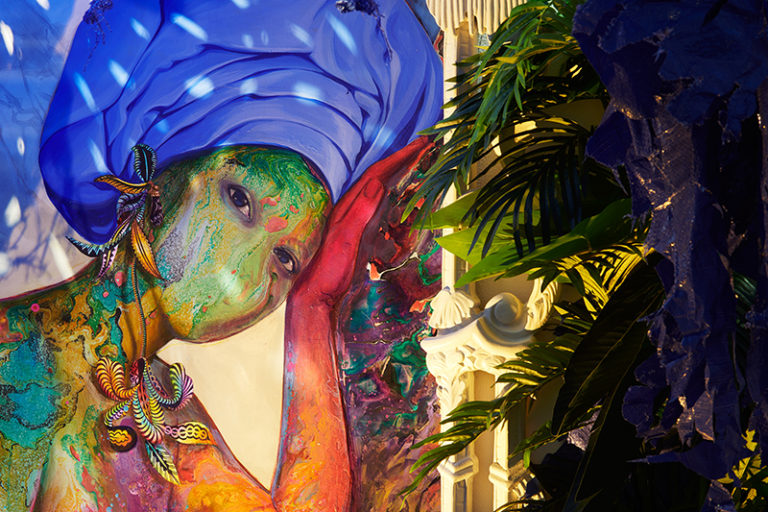Just last summer and fall, Firelei Báez brought a touch of joy to Harlem, along with a sense of her past. Even with five paintings, at the Schomburg Center of the New York Public Library, one might not have seen them as an immersive installation rather than a fiery testimony to African-American women. Even in a library setting, one might not have seen her as bookish at that. Look again, though, at James Cohan on the Lower East Side, and there is no getting around how much Báez can bring to a room. The title alone should have one thinking and wondering.
A Drexcyen Chronocommons (To Win the War You Fought It Sideways) (2019) no doubt refers to the “star chamber” in a song by Drexciya, while “chronocommons” suggests both a wrinkle in time and common grounds in the present. To get there, one has to penetrate a curtain of cut blue paper, which extends to cover the walls and ceiling of the gallery’s central room. Peeking out into the entryway, it offers an irresistible temptation. Lit from above, its cuts should also have one seeing stars. Beneath it, a floral translucent scrim recalls the unstretched canvas in Harlem. It gathers and disperses light, so that the entire room turns a deep blue.

Firelei Baez, A Drexcyen chronocommons (To win the war you fought it sideways), installation view, detail, (2019) photo Phoebe d’Heurle, courtesy the artist and James Cohan, New York.
As before, the artist’s reference points are eclectic. The paintings then evoked her childhood in the Dominican Republic while responding to Aspects of Negro Life—the 1934 murals on permanent display at the Harlem library, by Aaron Douglas. Here the stars recreate another moment in black history and the Afro-Caribbean Diaspora, on the other half of Hispaniola. They correspond, according to Báez, to the night sky at the onset of the Haitian Revolution. The first successful slave revolt, it overlapped the French Revolution and created the first Latin American republic.
A back room has more history, in hangings that build on documents related to the sugar trade. Seeing photographs recently of a Depression-era refinery, by Harold Haliday Costain, or the majestic occupant of the former Domino Sugar plant in Brooklyn by Kara Walker. As in Harlem, though, Báez is in a celebratory mood. Two paintings depict seated women, nude except for the head scarf on one and the wild colors of their skin. Quaintly framed and resting near the floor, they add further moments in and out of time.
The installation serves as both a woman’s private space and common grounds with the viewer. Bookish or not, it is touchy-feely, and it would take a determined eye to pick out constellations. Its blue and the bright colors of her paintings are two kinds of warm welcome. Art right now is eclectic to the point of confusion, but it may not hurt to seek common ground in installations.


